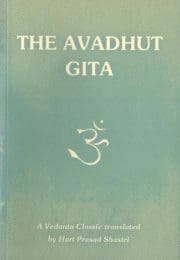Avadhut Gita
The Avadhut Gita consists of 176 verses. It states the non-dual teachings with extreme brevity and directness. The Avadhuta Gita is based on the understanding that when knowledge of the true Self (Atman) arises, all divisions, distinctions and not-knowing are dispelled; the nature of all is revealed as Self.
Here are verses two to five (it is customary to begin a work of this kind with a salutation to one’s teachers):
2. How can I salute the Self which is indestructible, which is all bliss, which in Itself and by Itself pervades everything, and which is inseparable from Itself?
3. I alone am, ever free from all taint. The world exists like a mirage within me. To whom shall I bow?
4. Verily, the one Self is all; free from differentiation and non-differentiation. Neither can it be said “It is” nor “It is not.” What a great mystery!
5. This is the whole substance of Vedanta; this is the essence of all knowledge, theoretical and intuitional. I am Atman, by nature impersonal and all-pervasive.
In its brevity and directness, the Avadhuta Gita has similarities with the Ashtavakra Gita.
The presentation in these Gitas is in a sense simple. They can help us to grasp essential points in the non-dual teachings, although the full meaning cannot be completely fathomed intellectually. These are not to be studied like text-books, their verses may be taken as texts for meditation and reflection.
If we are practising meditation regularly and making sincere efforts to apply the principle that all is ultimately one in Truth, we may find insight and support (and beauty) in these texts.
An ‘Avadhut’ is a true renunciate, in the sense that there remains no sense of attachment to anything, and in particular to the ego.


